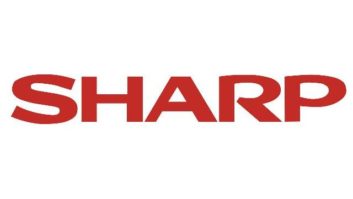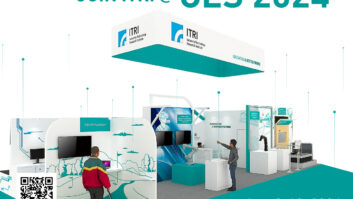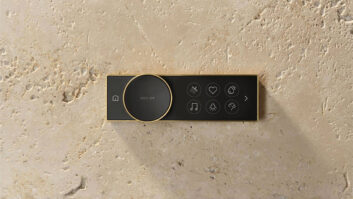New digital television products are once again expected to take center stage at CES, as manufacturers look to capitalize on growing consumer demand for future-ready big-screen monitors.
The following is a list of DTV products that many manufacturers plan for CES 2000 week.
This year, announcements from such manufacturers as Panasonic, Samsung, Sony and Zenith will focus on new satellite receiving capability for DirecTv standard, local and HDTV services. Look for new set-top boxes that will connect to the service’s new oblong dish.
Also look for manufacturers, including Samsung and Sony, to join Panasonic in adding IEEE 1394 digital connectors on various DTV products as they prepare for the arrival of two-way home A/V digital networks. And expect a number of new direct-view HDTV receivers and monitors, some of which include flat-faced widescreen picture tubes.
Faroudja: will show a high-definition processor/scaler that can automatically upconvert 1080i signals to a 1080 progressive format.
Model DVP5000 will also automatically boost 420p standard-definition DTV signals to a 960-progressive format. It will seamlessly de-interlace 1080 and 480 interlace signals, removing video artifacts in the process. The 720p format is passed through unprocessed. The unit will have a $30,000 retail price when it ships later in the first quarter.
Hitachi: Although not on the show floor, Hitachi planned a pre-CES press conference at the Rio Hotel to introduce new digital-capable sets based on LCD, a plasma-display panel, and a DTV-ready projection system using a Digital Micro-mirror Device (DMD) light engine.
JVC: The company is showing its first rear-screen projector based on the D-ILA display system. Called the D’Ahlia 3D Hologram, the projection set features a 61W” 16:9 screen and picture of high brightness and contrast capability. Model AV-61S901 is scheduled to ship in the second quarter at a $5,999 suggested retail price. It will present the 1080i HDTV format in native scan, and will also present 480i and 480p signal source.
The set connects to an external DTV decoder box via HD component video inputs or tunes directly to NTSC analog channels with its two-tuner PIP system. Michael Holmes, JVC television division general manager, said the company soon will have an announcement regarding decoder solutions.
Konka: New direct-view and rear-projection sets are in the Chinese-based company’s game plan for 2000. Konka plans to show a 50W” rear-projection HDTV-ready display (HD5098U) with a 16:9 widescreen aspect ratio and a native 1080i scan rate. Pricing was not set. Also slated is a 32″ 4:3 direct-view set that is 1080i scanning capable.
A fully integrated 34W” 16:9 widescreen HDTV set (HD3498U) also will be shown, with an introduction date slated for late 2000. The company’s 30W” fully integrated model, meanwhile, is now scheduled for delivery later this month at a $3,499 suggested retail price.
Panasonic: The company unveils a new digital set-top decoder that is believed to be the first to output all of the ATSC formats, as well as NTSC and DirecTv standard, local and HDTV programming. The new DTV set-top decoder (model TU-HD520) will carry a $1,099 suggested retail when it ships in May.
Other new products include an updated 34W” flat-faced 16:9 direct-view monitor, with built-in NTSC tuner, and the company’s first 65W” rear projection set. Model PT-65WXF95 will display both the 1080i and 720p HDTV formats in native form. Pricing will be announced later.
Philips: This is another company making a statement with high-scan flat-faced direct-view television displays. The company will show at CES two HD-capable widescreen direct view monitors and a fully integrated HDTV receiver with the flat tube design.
The integrated set (model 34PH9915) uses a 34W” 16:9 picture tube. It will scale all formats to a 1080i scan rate, except NTSC analog sources, which are scaled to a 540p format. Scheduled to ship in the second quarter, the set will carry a $5,000 suggested retail price.
New flat-tube monitors include the 30PW9815 and the 34PW9815, which feature 16:9 screen sizes of 30W” and 34W”, respectively. Both scan images at a 1080i rate, include dual NTSC tuners, and connect to a digital decoder box via HD component video inputs. They will ship in the second quarter at suggested retails of $3,000 and $4,000, respectively.
Three HD-capable rear-projection monitors and one fully integrated HDTV rear-projection model are also in the plans for 2000. The company is currently selling the 64PH9905 HDTV for a $9,990 suggested retail. It includes 9″ CRTs and broadband inputs.
High-scan projection monitors include two 60″ models in each of the 16:9 and 4:3 aspect ratios and a 55W” widescreen model. All are shipping this summer and scan the 1080i and 480p formats, natively. They include dual NTSC tuners and connect to an outboard ATSC decoder box via HD component video inputs.
The 60″ 4:3 display (60PP9601) will carry a $4,200 suggested retail, the 60W” display (60PP9701) is $5,500, and the 55W” 16:9 display (55PP9701) is $5,000.
In the 480p segment, Philips offers a new plasma display panel (42FD9932) that includes a 42W” 16:9 and an 852 x 480 pixel resolution, for a $10,000 suggested retail price starting later this quarter. A version bundled with an E-box companion NTSC tuner/chassis also will be available.
Samsung: Starting in the second quarter, Samsung will offer two HD-ready rear-screen projection TVs that display in the 720p native-scan format. Both models are based on new Ferro Electric Liquid Crystal technology. DisplayTech developed the system in 1990.
The 43W” 16:9 version will carry a suggested price of $5,999; a 50W” 16:9 version will also be available in the second quarter, at a $6,999 expected retail price. Both models will need set-top decoders connected via HD component video or RGB via VGA jacks to present DTV broadcasts.
Among other things, the FLCD technology enables Samsung to develop very thin rear-projection cabinets. The 43W version measures just 14″ deep. Panel resolution is rated at 1,280 x 720 pixels, and connections include HDTV component, DVD component and PC input.
Samsung also plans to expand its Tantus series with the introduction of three flat-screen direct-view sets, called Pure Flat. These will include a 27″ 4:3 model (TSK2700F, $1,099), a 32″ 4:3 model (TSK3200F, $1,699) and a 30W” 16:9 model (TSK3000F, $2,199).
All are billed as “digital-ready” and will display images in the 480p SDTV native-scan rate when connected via HD component video jacks to DTV set-top box.
Additionally, the models incorporate dual NTSC tuners and video processing to present interlace signals in progressive-scan mode. All three models will ship in August.
Sharp: Keeping stride with a developing trend, Sharp will unveil under its SharpVision brand a widescreen direct-view monitor that will scan the 1080i HDTV format. Model 34N-WF5H features a 34W” widescreen picture tube, HD component video inputs, 1080i HDTV scan capability, and dual NTSC tuners. It is scheduled to ship in March at a $3,995 suggested retail price.
The company will also showcase its recently announced CG-Silicon-based LCD rear-projection set. The 60W” widescreen monitor (model LC-R60HDU) promises a brighter, sharper picture, with purer colors and higher contrast levels than conventional LCD displays. It is scheduled to ship later this quarter at a $49,995 suggested retail price.
Sharp will also unveil a 50W” plasma-display panel, model LC-PD50U, which will present the 720p HDTV format and line-double conventional NTSC sources. It ships later this quarter at a price to be announced.
Sony: The company came to CES loaded with technologies designed to interface with the digital home entertainment network of the future. Pre-show specifics from the company were sketchy, but new models offer IEEE-1394 iLink digital connections with provisions for the DTCP (5C) digital content protection and copy-management system. Many products will also use HAVi two-way device communication protocols.
Vic Pacor, Sony’s TV and digital media VP, said pricing for new products “will be more accessible” than the company’s first-generation DTV products.
Plans for new ATSC sets include four projection televisions and two direct-view models.
Pacor said the projection sets feature “all new tooling.” Sets will feature onboard ATSC tuners, “but any other service than ATSC terrestrial broadcasts will be via iLink connected external chassis.” He acknowledged that both satellite and cable delivered receivers are included.
Among the bigger announcements at the show, Pacor said his company is introducing an ATSC set-top decoder box that will also receive DirecTv standard, local and HD services.
“We’re bullish about DirecTv, but we are also bullish about the potential for cable, cable modems, and data-casting devices,” Pacor said. “There is a lot on the horizon, some of which has been standardized and some of which is yet to be standardized.”
Thomson: The company recently showed its first fully integrated direct-view HDTV, at a pre-CES press conference. The RCA-brand model (F3831) incorporates ATSC/DirecTv HD decoding and a 38W” 16:9 Performax picture tube.
A similar model (PS38000) will be shipped under the ProScan brand. Both are slated for spring delivery at prices to be announced. A smaller 34″W ProScan model will be available later in the year.
The company has previously shown RCA and ProScan lines of high-resolution 4:3 multimedia monitors in direct-view (32″, 36″ and 27″) and rear-PTV (52″ and 61″) configurations.
Thomson recently jumped into the plasma-display panel category using its ProScan brand. The first model (PSP4200) is 42W” with SDTV (480p) resolution.
Toshiba: The company is building on its broad assortment of HDTV-capable monitors and fully integrated sets with the introduction of its first flat-faced widescreen direct view unit.
Model CW34X92 is a widescreen high-scan monitor that features a flat-faced tube in the 34W” 16:9 configuration. It will scan the 1080i HDTV format natively, includes dual NTSC tuners, and effectively line doubles interlaced analog sources.
The monitor includes two sets of HD component video inputs for connection with a set-top box, such as the Toshiba DST-3000, which is due in the first quarter at a $999 suggested retail. The box will decode ATSC terrestrial signals as well as DirecTv standard, local and HD broadcasts. It also includes an NTSC tuner.
Zenith: Although specifics were not ready as this went to press, the company is preparing to announce a number of new products for its first involvement with a direct-broadcast satellite system to support its HDTV line. Company executives said they will offer a set-top box that incorporates decoding for ATSC terrestrial broadcasts as well as DirecTv’s standard, local and HDTV services.
The new set-top box will ship in the fourth quarter and will receive all 18 ATSC formats and output at user-selectable levels for 480i, 480p, 720p and 1080i. It also includes an NTSC tuner. Connection to a DTV monitor is made either through RGB via VGA or HD component video outputs.
Although product specifics may wait until Zenith’s spring dealer meeting, a variety of new HD-ready TV displays are in the CES booth.
These include new 4:3 direct-view sets in the 32″ and 36″ screen sizes that are 1080i scan-format capable; two 38W” 16:9 1080i-ready direct-view monitors in tabletop and vertical furniture styling; a HD-ready 27″ flat-screen direct-view model; and an HD-capable LCD-based rear-projection set, which will offer a 60″ screen.
Zenith is also demonstrating a 60W” HD-capable plasma-display panel with 1,365 x 768 resolution. Zenith’s parent, LG Electronics, makes the panel, but there are no current marketing plans.













